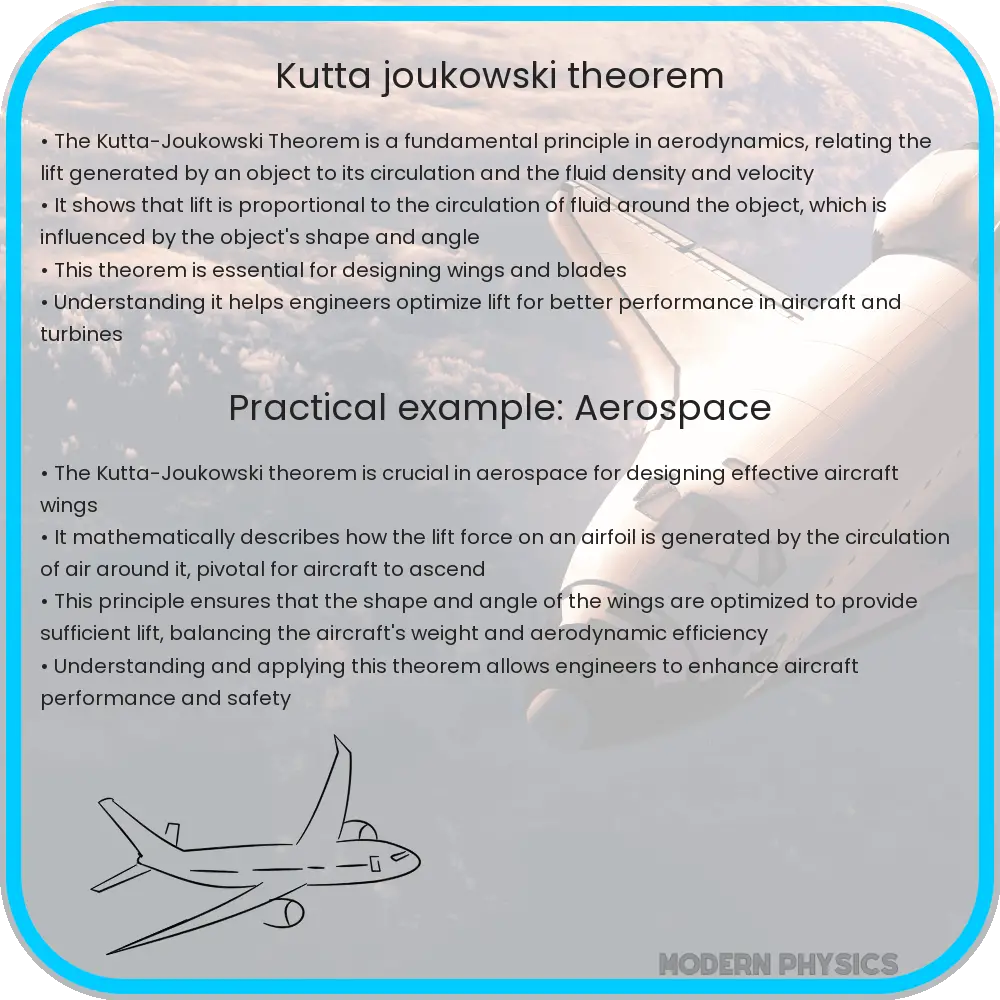The Kutta-Joukowski theorem links the lift generated by an airfoil with the circulation of airflow, air density, and velocity, fundamental in fluid dynamics.

Understanding the Kutta-Joukowski Theorem
The Kutta-Joukowski theorem is a fundamental principle in the field of fluid dynamics and is critically important in understanding how lift is generated in airfoils, such as airplane wings. Developed independently by Nikolai Joukowski and Martin Kutta around the early 20th century, this theorem links the lift generated by an airfoil with the circulation of the airflow around it and the density and velocity of the fluid.
Lift Force and Airfoils
The concept of lift is essential in aerodynamics, particularly concerning the functionality of airfoils. An airfoil, in basic terms, is a shape designed to generate lift when air flows around it, typical examples being aircraft wings, helicopter blades, or even the sails on a boat. The shape of an airfoil means that air moves faster over the top surface than the bottom surface, creating a difference in pressure that lifts the airfoil upward.
Circulation and its Role in Generating Lift
Circulation refers to the net rotation of air around the airfoil and is a pivotal element in the physics of lift. According to the Kutta-Joukowski theorem, lift (L) can be calculated by the following equation:
L = ρ * V * Γ
- ρ (rho) represents the air density
- V is the velocity of the free stream air
- Γ (Greek letter Gamma) signifies the circulation, which is the integral of the velocity component tangential to a closed curve surrounding the airfoil
Circulation is effectively a measure of how much turning motion the airfoil imparts on the airflow. Airfoils are designed to create a positive circulation which, according to the right-hand rule, corresponds to a downward deflection of the flow which by Newton’s third law, results in an upward lift.
Kutta Condition
Integral to accurately predicting the lift using the Kutta-Joukowski theorem is the Kutta condition. This condition imposes a requirement that the air velocity must be finite at the trailing edge of the airfoil. Essentially, it ensures that the flow does not exhibit singular behavior (infinitely large values) at the trailing edge, which is physically unrealistic. The practical effect of this requirement is that the airfoil must have a sharp trailing edge, which allows the smooth detachment of airflow, helping maintain stable and controlled lift characteristics.
An understanding of these principles provides a strong foundation for the design and analysis of any technology involving lift and fluid dynamics, from aircraft to race cars to wind turbines. The intricate balance between shape (geometry), air speed, and air density encapsulates many of the challenges facing engineers and physicists today.
Applications of the Kutta-Joukowski Theorem
The Kutta-Joukowski theorem isn’t just theoretical; it has real-world applications that affect a variety of engineering fields. For example, it is vitally important in the design and optimization of aircraft wings. Aerospace engineers use this theorem to calculate the necessary circulation to achieve desired lift characteristics for different aircraft configurations. Similarly, in the automotive industry, engineers apply principles from the theorem to design more efficient and stable race car spoilers which operate under similar fluid dynamic principles as airfoils.
Beyond vehicles, the theorem also plays a crucial role in the development of turbines, such as those used in wind or hydroelectric power generation. Understanding and applying the Kutta-Joukowski theorem allows engineers to design blades that maximize efficiency by optimizing the lift force exerted by moving air or water.
Conclusion
The Kutta-Joukowski theorem bridges a crucial gap between theoretical physics and practical engineering, providing a detailed explanation of how lift is generated in various airfoil applications. By mathematically linking the circulation of air around an airfoil with the lift it generates, this theorem creates a toolset for engineers and physicists to apply in real-world scenarios, from the aerospace industry to renewable energy solutions.
While the theorem itself can be mathematically intense, its implications are profound, enabling more informed and innovative designs in technology that rely on fluid dynamics. For students and professionals alike, gaining an understanding of the Kutta-Joukowski theorem is an investment in understanding the essence of how and why objects are able to defy gravity through aerodynamic lift – a fundamental enabler of our modern way of life.
Indeed, the sophistication of today’s engineering feats – whether airliners crossing continents, race cars achieving unprecedented speeds, or turbines contributing to energy sustainability – is testament to the enduring legacy of foundational principles like the Kutta-Joukowski theorem.
